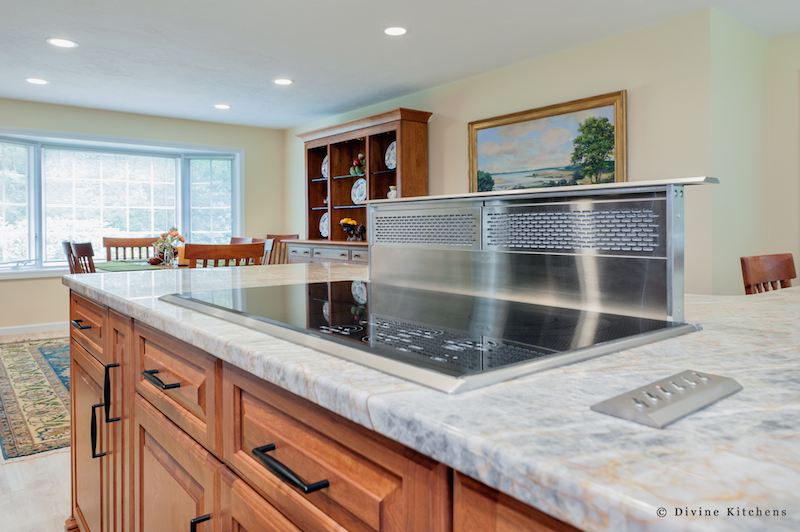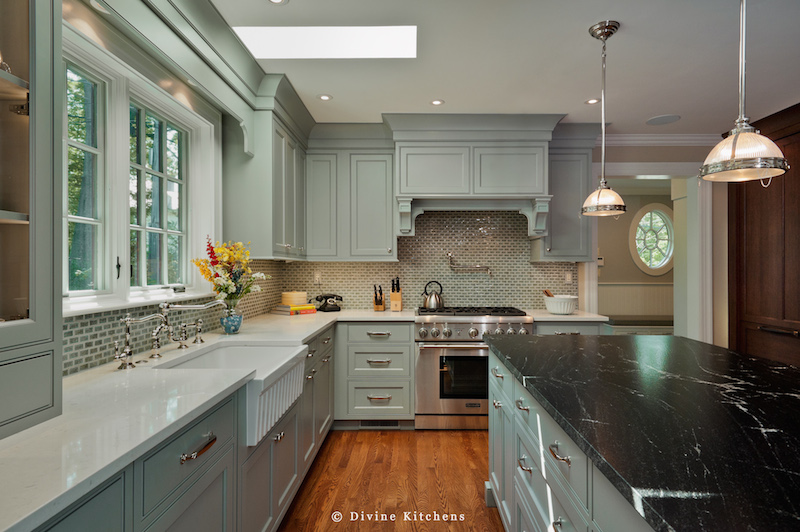How To Vent Your Kitchen For Performance And Protection
The range hood in many kitchens is the anchor that holds the whole style of the kitchen together & becomes the focal point not only for usage but also for aesthetics. After a few guidelines for functionality, placement and measurement are followed, the possibilities are endless when it comes to the design & feel of the range hood. Looking to add some warmth and beauty into the design of your kitchen? A custom stained wood hood will do the trick. Leaning towards a more modern & sleek look? A custom stainless steel hood could be the last puzzle piece you need in your kitchen design.
Range hoods have a lot of responsibility and are thus a key component in keeping your kitchen safe. Functionally, they draw moisture, grease, cooking odors, smoke & more out of the air in the kitchen.
When remodeling, remember the following guidelines to keep your kitchen well ventilated and safe:
- The depth of the hood should cover at least half of the front burner
- 24"-26": The distance from the cooktop to the bottom of the vent, depending on range type and size
- Do not locate the cooking surface under an operable window
- Window treatments above the cooking surface should not use flammable materials
- A fire extinguisher should be located near the exit of the kitchen, easily accessible & away from cooking equipment
- Air must be vented through the wall or the roof to the outdoors & recirculation is not allowed in most jurisdictions--this is where air is drawn through carbon filters, then pushed back into the kitchen
- Venting through the attic is no longer up to code due to the risk of fire
Kitchen Range Hood Options
There are three main factors involved in picking the right style and design of a range hood:
Range Hood Blower Size: It important to size the fan based on your cooking habits; bigger isn't always better as a larger blower can waste energy & pull heated or air conditioned air out as well.
Range Hood Size: Most range hoods can be purchased with a 22-27" depth with more coverage better for island vents & serious cooks. Generally the hood should be 6" larger in width than the cook top.
Range Hood Design: Blower position and the shape of the hood are the two biggest components to consider. Flat bottom hoods versus pyramid shaped design both offer advantages over the other depending on design needs & the location of the cook top.
Down Draft Vent
The down draft style ventilation system capture the cooking odors, steam and grease & can be lowered out of sight when it's not in use. This is an ideal ventilation system for modern or smaller spaces. You can see below how it was used in an island configuration where a more traditional hood could not be used.

Wood Range Hood
Wood hoods are a big trend in kitchens & can range in design to offer a plethora of design options for any home owner. Wood cabinets can be created to conceal your ventilation system for a way to seamlessly tie your vent system into your cabinetry & offer more storage space. A mix matched wooden hood is also a great option for a rustic feel.
Island Hood
If your cooking station is located in your island, a chimney style vent hood is a great option to provide maximum ventilation. It is a statement and focal point for the space; check out an island hood below in a recent remodel we love!
Custom Stainless Hood
For larger kitchens, a custom stainless steal hood is a great way to add of twist of contemporary to an already elegant kitchen. Paired with wooden cabinets & marble tile it's a sure fire way to gain design points.
Plaster Hood
If metal & wood are off the table, consider a plaster hood design, like the one below. A shelving unit was added to the design of the hood cover to offer a great way to show off decor & keep counter space free.
Final Thoughts
When making the final decision for what design, size and style you want in a kitchen ventilation system, remember to keep these questions at the front of your mind & you won't go wrong: What is my cooking style & what are my ventilation needs? Do I want a statement range hood or a concealed range hood? How will the location of my cooking surface affect my needs in a ventilation system?
We can't wait to hear what you like and what style you are going to use on your next remodel!







